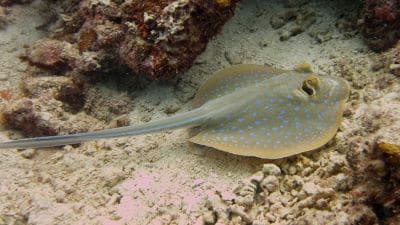Home › A-Z Destinations › Asia › Thailand › Koh Tao › Hin Pee Wee
Scuba Diving Hin Pee Wee Dive Site
There are around 80 dive schools on Koh Tao and they visit some spots less often than others. This cluster of small pinnacles is one of them!
This segment contains helpful information about the dive site Hin Pee Wee off the west coast of Sairee Beach, with extra details about the unique marine life living in the area.
Which Month is Best for Diving at Koh Tao?
The Chumphon Archipelago contains dozens of sun-kissed bays on the islands. But, the premier hotspots for scuba divers are:
- Koh Phangan
- Koh Samui
- Mu Ko Chumphon National Park
- Turtle Island (aka Koh Tao)
Koh Tao is a compact kidney-shaped island that has about twenty one (21) square kilometres of total land mass.
Nevertheless, the pristine white sand beaches and azure blue water have transformed Koh Tao Island into one of the top places for a scuba diving holiday in Thailand.
Here's the deal:
Most scuba divers want to explore destinations that are sunny and have calm conditions underwater. Well, Koh Tao has over three hundred days of sunshine per year and the temperature of the water is fairly constant around 29° Celsius (84° Fahrenheit).
As a consequence of that, it's fair to say Koh Tao diving and snorkeling is an annual activity. But, divers need to be mindful that the southwest monsoons usually arrive towards the end of October and may continue until the end of January.
At certain times of the year, the south western gulf can have thirty (30) metres of underwater visibility. Hence, the best months for divers to enjoy clear water dives are July, August, and September.
Pro Tip: Check the sea life section for fun facts about whale sharks that often show up at Koh Tao Island in April and May.
Aquatic Life at Hin Pee Wee
Koh Tao dive sites are good places to see big fishes (e.g. pelagics). Plus, divers should expect to catch sightings of common marine life native to the lower Gulf of Thailand, especially during the plankton blooms in March and April, such as:
- Bearded scorpionfish (Scorpaenopsis barbata)
- Blue ring angelfish (Pomacanthus annularis)
 Blue spotted stingray (Taeniura lymma)
Blue spotted stingray (Taeniura lymma)- Emperor angelfish (Pomacanthus imperator)
- Hermit crab (Paguroidea)
- Longnose emperor fish (Lethrinus olivaceus)
- Pennant coralfish (Heniochus acuminatus)
- Moon wrasse (Thalassoma lunare)
- Sea Turtles
- Tiger grouper (Epinephelus fuscoguttatus)
- White eyed moray eel (Gymnothorax thyrsoideus)
- Yellowtail barracuda (Sphyraena flavicauda)
Pro Tip: The site offers good opportunities to explore sea life that lives around hard and soft corals. For example, the hard varieties include brain, table, and staghorn corals. You should also see whip corals, sea anemones, and large sea fans swaying in the currents.
Tips for Diving at Hin Pee Wee
The easiest way to find the main rock pinnacle at Hin Pee Wee dive spot is to swim about thirty (30) metres north of HTMS Sattakut wreck.
Or, you could swim south of White Rock dive site for about two hundred (200) metres and you will find the central pinnacle about eight (8) metres below the surface.
This topographical feature is quite shallow and often visible from the surface. But, most of the satellite pinnacles that surround it are a lot deeper bottoming out around twenty nine (29) metres down.
For example:
The site is less than two (2) kilometres from the longest beach in Koh Tao (Sairee Beach). So, if you already have the Advanced Open Water Diver certification you could also combine the dive with some deep diving, underwater photography, or Tec training.
Sometimes, the visibility can be around fifteen (15) metres, especially when the current is not too strong. Hence, some of the local scuba shops will dive the big rock at Hin Pee Wee in tandem with the sunken Thai Navy Sattakut shipwreck.
This provides a good opportunity to catch sightings of marine snakes and large turtles sheltering around the stony monolithic structures.
Pro Tip: Another section contains a list of the best places to find marine snakes and sea kraits, such as India, the Philippines, and Thailand.
Related Information and Help Guides
- Aow Leuk Dive Site Koh Tao for Diving and Snorkeling
- Hin Wong Bay Dive Site Koh Tao East Coast in Thailand
- Information about the Shark Island Dive Site at Koh Tao
- Is Chumphon Pinnacle the Best Place to Dive in Koh Tao?
- Laem Thian Dive Sites in Koh Tao for Beginners
- Sail Rock Dive Site in the Lower Gulf of Thailand
- Koh Samui Scuba Diving and Snorkeling Sites
- Where are the Biggest Wreck Dives in Thailand?
Pro Tip: This short clip [1:53 seconds] presented by "matheeq" contains footage of the interesting and lively sea life native to Hin Pee Wee diving site on the west coast of Koh Tao.